Lancia Musa 2009 Owner handbook (in English)
Manufacturer: LANCIA, Model Year: 2009, Model line: Musa, Model: Lancia Musa 2009Pages: 218, PDF Size: 3.7 MB
Page 141 of 218
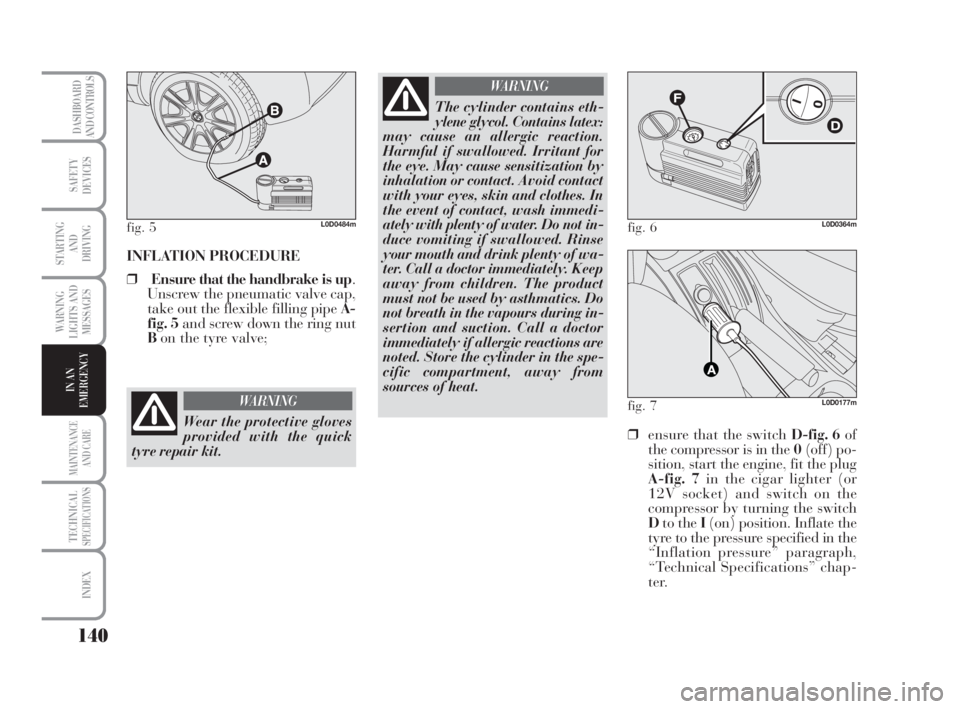
140
WARNING
LIGHTS AND
MESSAGES
MAINTENANCE
AND CARE
TECHNICALSPECIFICATIONS
INDEX
DASHBOARD
AND CONTROLS
SAFETY
DEVICES
STARTING
AND
DRIVING
IN AN
EMERGENCY
INFLATION PROCEDURE
❒Ensure that the handbrake is up.
Unscrew the pneumatic valve cap,
take out the flexible filling pipe A-
fig. 5and screw down the ring nut
Bon the tyre valve;
fig. 5L0D0484m
Wear the protective gloves
provided with the quick
tyre repair kit.
WARNING
The cylinder contains eth-
ylene glycol. Contains latex:
may cause an allergic reaction.
Harmful if swallowed. Irritant for
the eye. May cause sensitization by
inhalation or contact. Avoid contact
with your eyes, skin and clothes. In
the event of contact, wash immedi-
ately with plenty of water. Do not in-
duce vomiting if swallowed. Rinse
your mouth and drink plenty of wa-
ter. Call a doctor immediately. Keep
away from children. The product
must not be used by asthmatics. Do
not breath in the vapours during in-
sertion and suction. Call a doctor
immediately if allergic reactions are
noted. Store the cylinder in the spe-
cific compartment, away from
sources of heat.
WARNING
❒ensure that the switch D-fig. 6of
the compressor is in the 0(off) po-
sition, start the engine, fit the plug
A-fig. 7in the cigar lighter (or
12V socket) and switch on the
compressor by turning the switch
Dto the I(on) position. Inflate the
tyre to the pressure specified in the
“Inflation pressure” paragraph,
“Technical Specifications” chap-
ter.
fig. 6L0D0364m
fig. 7L0D0177m
135-164 MUSA 1ed GB 10-07-2008 9:38 Pagina 140
Page 142 of 218
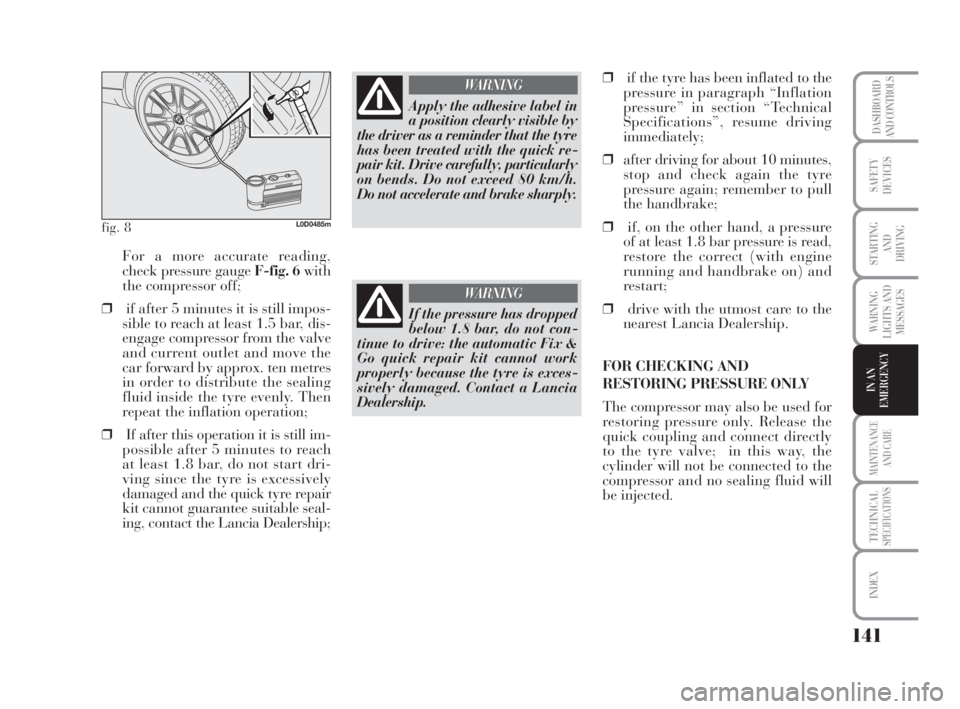
141
WARNING
LIGHTS AND
MESSAGES
MAINTENANCE
AND CARE
TECHNICALSPECIFICATIONS
INDEX
DASHBOARD
AND CONTROLS
SAFETY
DEVICES
STARTING
AND
DRIVING
IN AN
EMERGENCY
For a more accurate reading,
check pressure gauge F-fig. 6with
the compressor off;
❒if after 5 minutes it is still impos-
sible to reach at least 1.5 bar, dis-
engage compressor from the valve
and current outlet and move the
car forward by approx. ten metres
in order to distribute the sealing
fluid inside the tyre evenly. Then
repeat the inflation operation;
❒If after this operation it is still im-
possible after 5 minutes to reach
at least 1.8 bar, do not start dri-
ving since the tyre is excessively
damaged and the quick tyre repair
kit cannot guarantee suitable seal-
ing, contact the Lancia Dealership;
fig. 8L0D0485m
Apply the adhesive label in
a position clearly visible by
the driver as a reminder that the tyre
has been treated with the quick re-
pair kit. Drive carefully, particularly
on bends. Do not exceed 80 km/h.
Do not accelerate and brake sharply.
WARNING
If the pressure has dropped
below 1.8 bar, do not con-
tinue to drive: the automatic Fix &
Go quick repair kit cannot work
properly because the tyre is exces-
sively damaged. Contact a Lancia
Dealership.
WARNING
❒if the tyre has been inflated to the
pressure in paragraph “Inflation
pressure” in section “Technical
Specifications”, resume driving
immediately;
❒after driving for about 10 minutes,
stop and check again the tyre
pressure again; remember to pull
the handbrake;
❒if, on the other hand, a pressure
of at least 1.8 bar pressure is read,
restore the correct (with engine
running and handbrake on) and
restart;
❒drive with the utmost care to the
nearest Lancia Dealership.
FOR CHECKING AND
RESTORING PRESSURE ONLY
The compressor may also be used for
restoring pressure only. Release the
quick coupling and connect directly
to the tyre valve; in this way, the
cylinder will not be connected to the
compressor and no sealing fluid will
be injected.
135-164 MUSA 1ed GB 10-07-2008 9:38 Pagina 141
Page 143 of 218

142
WARNING
LIGHTS AND
MESSAGES
MAINTENANCE
AND CARE
TECHNICALSPECIFICATIONS
INDEX
DASHBOARD
AND CONTROLS
SAFETY
DEVICES
STARTING
AND
DRIVING
IN AN
EMERGENCY
CYLINDER REPLACEMENT
PROCEDURE
To replace the cylinder proceed as fol-
lows:
❒disconnect connection A-fig. 9;
❒turn the cylinder to be replaced
anticlockwise and raise it;
❒fit the new cylinder and turn it
clockwise;
❒connect connection Ato the cylin-
der and fit the transparent tube B
into the space provided.
fig. 9L0D0368m
Remember to inform the
workshop that the tyre has
been treated with a quick repair kit.
Give the instruction booklet to the
tyre repair workshop personnel.
WARNINGREPLACING
A WHEEL
GENERAL INSTRUCTIONS
Wheel changing and correct use of the
jack and of the small spare wheel call
for some precautions as listed below.
IMPORTANT If the vehicle is
equipped with a “Fix&Go (quick tyre
repair kit)”, see the relative instruc-
tions shown in the previous chapter.
135-164 MUSA 1ed GB 10-07-2008 9:38 Pagina 142
Page 144 of 218

143
WARNING
LIGHTS AND
MESSAGES
MAINTENANCE
AND CARE
TECHNICALSPECIFICATIONS
INDEX
DASHBOARD
AND CONTROLS
SAFETY
DEVICES
STARTING
AND
DRIVING
IN AN
EMERGENCY
The small spare wheel is
specific for your car. Do not
use it on cars of different models. Do
not use spare wheels of different
models on your car. The small spare
wheel must only be used in an emer-
gency. Never use it for more than
strictly necessary and never exceed
80 km/h. On the small spare wheel
there is an orange label, summariz-
ing the main warnings regarding
small spare wheel usage restrictions.
Never remove or cover the label.
Never apply any hub cap on the
small spare wheel. The label con-
tains the following indications in
four languages: Warning! For tem-
porary use only! 80 km/h max! Re-
place the standard wheel as soon as
possible. Do not cover this instruc-
tion.
WARNING
The driving characteristics
of the car are different
when the small spare wheel is in-
stalled. Avoid violent accelerations
and braking, sharp steering and fast
bending. The overall duration of the
small spare wheel is of about 3000
km, after which the relevant tyre
must be replaced with another one
of the same type. Never install a tra-
ditional tyre on a rim designed to be
used as a small spare wheel. Repair
and refit the standard wheel as soon
as possible. Using two or more small
spare wheels at the same time is for-
bidden. Do not apply grease to the
bolt threading before assembly: they
might come unscrewed.
WARNING
The jack may only be used
to replace wheels on the car
which it equips or other cars of the
same model. Never use the jack for
other purposes, such as lifting other
car models. Never use the jack to
carry out repairs under the car. In-
correct positioning of the jack may
cause the car to fall. Do not use the
jack for loads higher than those
shown on the label. Never install
snow chains on the small spare
wheel; if a front tyre (driving wheel)
is punctured and you need to use
snow chains, use a standard wheel
from the rear axle and install the
small spare wheel on the rear axle.
This way, with two normal front dri-
ving wheels, you can install the snow
chains on them, thus resolving the
emergency.
WARNING
135-164 MUSA 1ed GB 10-07-2008 9:38 Pagina 143
Page 145 of 218
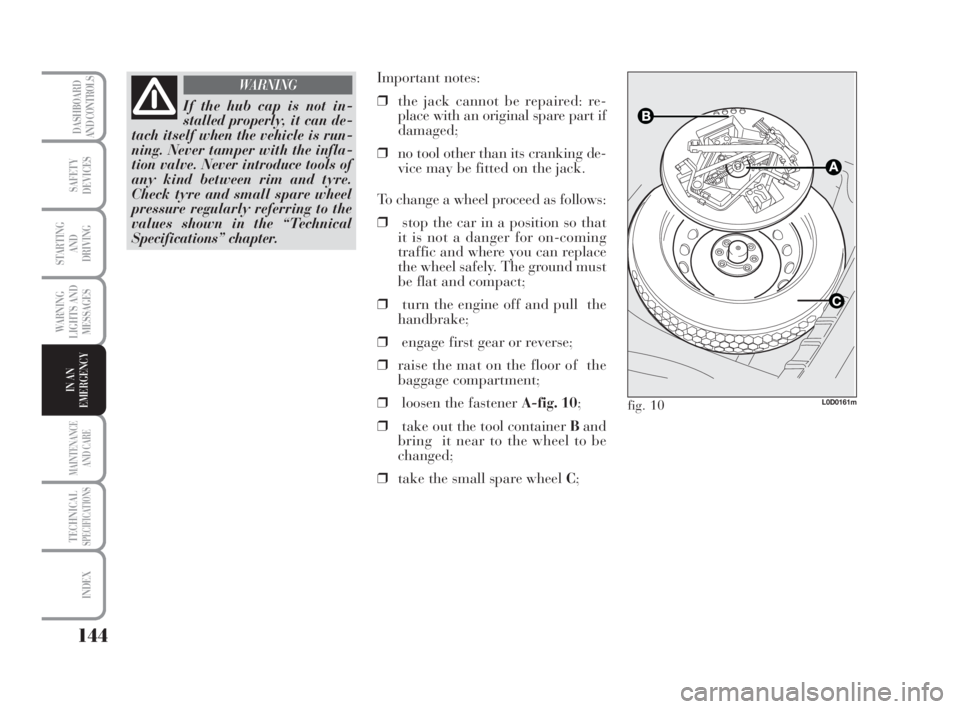
144
WARNING
LIGHTS AND
MESSAGES
MAINTENANCE
AND CARE
TECHNICALSPECIFICATIONS
INDEX
DASHBOARD
AND CONTROLS
SAFETY
DEVICES
STARTING
AND
DRIVING
IN AN
EMERGENCY
If the hub cap is not in-
stalled properly, it can de-
tach itself when the vehicle is run-
ning. Never tamper with the infla-
tion valve. Never introduce tools of
any kind between rim and tyre.
Check tyre and small spare wheel
pressure regularly referring to the
values shown in the “Technical
Specifications” chapter.
WARNINGImportant notes:
❒the jack cannot be repaired: re-
place with an original spare part if
damaged;
❒no tool other than its cranking de-
vice may be fitted on the jack.
To change a wheel proceed as follows:
❒stop the car in a position so that
it is not a danger for on-coming
traffic and where you can replace
the wheel safely. The ground must
be flat and compact;
❒turn the engine off and pull the
handbrake;
❒engage first gear or reverse;
❒raise the mat on the floor of the
baggage compartment;
❒loosen the fastener A-fig. 10;
❒take out the tool container Band
bring it near to the wheel to be
changed;
❒take the small spare wheel C;
L0D0161mfig. 10
135-164 MUSA 1ed GB 10-07-2008 9:38 Pagina 144
Page 146 of 218

145
WARNING
LIGHTS AND
MESSAGES
MAINTENANCE
AND CARE
TECHNICALSPECIFICATIONS
INDEX
DASHBOARD
AND CONTROLS
SAFETY
DEVICES
STARTING
AND
DRIVING
IN AN
EMERGENCY
fig. 11L0D0397m
fig. 12L0D0163m
❒for cars with alloy rims, remove
the hub cap using the screwdriver
provided, by levering at the ap-
propriate groove E- fig. 11, as
shown in the figure;
❒loosen the bolts of the wheel to be
replaced by about one turn with
the wrench provided E-fig. 12; if
the car is fitted with alloy rims,
shake the car to facilitate remov-
ing the rim from the wheel hub;❒activate the device F- fig. 13so as
to extend the jack, until the groove
Gon the upper part of the jack fits
correctly into the lower profile H
visible on the car body next to the
indicationI(at approx. 60 cm
from the centre of the front wheel
or 80 cm from the centre of the
rear wheel);
❒advise any personnel present in
the area that the car is about to be
lifted; it is therefore vital not to
stand near it or to touch it until it
has been lowered again;❒fit the handle L- fig. 13to as to
be able to operate the jack and
continue to raise the care until it is
a few centimetres off the ground;
❒for versions with wheel cap, re-
move the wheel cap after loosen-
ing the 3 fastening bolts and fi-
nally loosen the fourth bolt and
extract the wheel;
❒for versions with snap-fitted wheel
cap, remove the cap, taking care
not to damage it;
❒ensure that the surfaces of the
small spare wheel in contact with
the hub are clean and free from
impurities that could, subse-
quently, lead to the loosening of
the fastening bolts;
L0D0164mfig. 13
135-164 MUSA 1ed GB 10-07-2008 9:38 Pagina 145
Page 147 of 218

146
WARNING
LIGHTS AND
MESSAGES
MAINTENANCE
AND CARE
TECHNICALSPECIFICATIONS
INDEX
DASHBOARD
AND CONTROLS
SAFETY
DEVICES
STARTING
AND
DRIVING
IN AN
EMERGENCY
fig. 14L0D0165mfig. 15L0D0166m
❒fit the spare wheel, ensuring that
the holes coincide M-fig. 14with
their respective centring pins N;
❒using the wrench provided, tighten
the four fastening bolts;
❒turn the jack handle to lower the
car and remove the jack;
❒using the wrench provided, screw
the bolts right down in a criss-
cross fashion, in the sequence
shown in the figureREFITTING THE
STANDARD WHEEL
Following the procedure described
previously, raise the car and remove
the small spare wheel.
Versions with steel rims
Proceed as follows:
❒make sure the contact surfaces be-
tween spare wheel and hub are
clean and free from impurities so
that the fastening bolts will not
come loose;
❒fit the standard wheel by inserting
the first two-threaded bolt in the
hole nearest to the inflation valve;❒fit the wheel cap, ensuring that the
groove (in the cap itself) coincides
with the inflation valve. Then fit
the other three bolts;
❒for versions with snap-fitted wheel
cap, press down on the edge of the
cap, with the palm of your hand
(do not strike it) against the wheel;
❒Using the wrench provided, se-
curely tighten the fastening bolts;
❒lower the car and remove the jack;
❒Using the wrench provided, fully
tighten the bolts in the sequence
shown in fig. 15;
IMPORTANT If it is not fitted prop-
erly, the wheel cap may detach itself
when the vehicle is running.
135-164 MUSA 1ed GB 10-07-2008 9:38 Pagina 146
Page 148 of 218
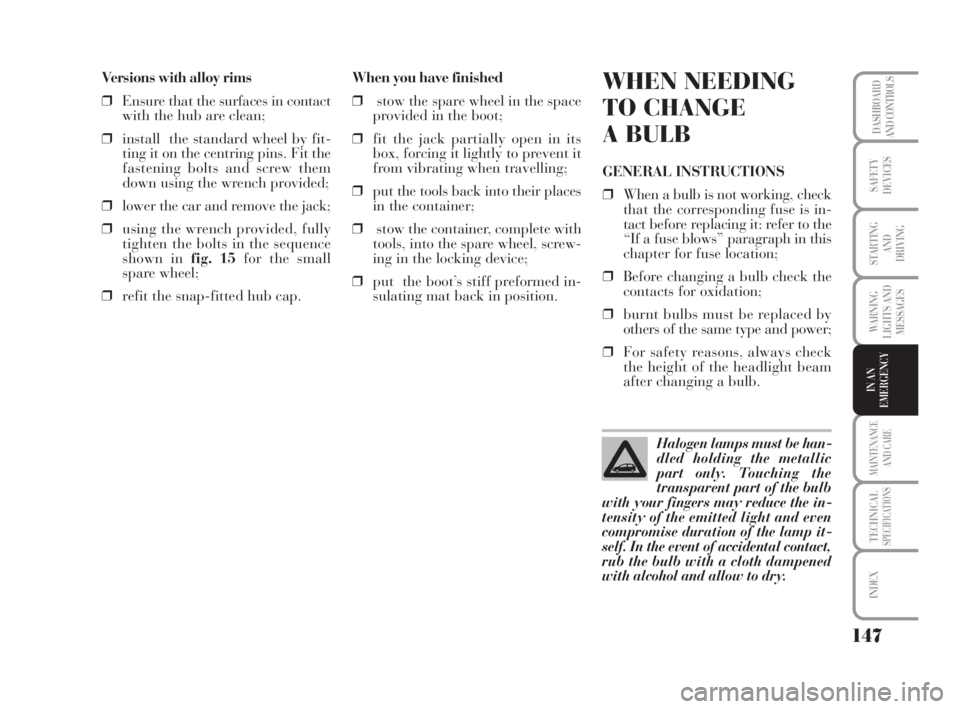
147
WARNING
LIGHTS AND
MESSAGES
MAINTENANCE
AND CARE
TECHNICALSPECIFICATIONS
INDEX
DASHBOARD
AND CONTROLS
SAFETY
DEVICES
STARTING
AND
DRIVING
IN AN
EMERGENCY
Versions with alloy rims
❒Ensure that the surfaces in contact
with the hub are clean;
❒install the standard wheel by fit-
ting it on the centring pins. Fit the
fastening bolts and screw them
down using the wrench provided;
❒lower the car and remove the jack;
❒using the wrench provided, fully
tighten the bolts in the sequence
shown in fig. 15for the small
spare wheel;
❒refit the snap-fitted hub cap.When you have finished
❒stow the spare wheel in the space
provided in the boot;
❒ fit the jack partially open in its
box, forcing it lightly to prevent it
from vibrating when travelling;
❒put the tools back into their places
in the container;
❒stow the container, complete with
tools, into the spare wheel, screw-
ing in the locking device;
❒put the boot’s stiff preformed in-
sulating mat back in position.WHEN NEEDING
TO CHANGE
A BULB
GENERAL INSTRUCTIONS
❒When a bulb is not working, check
that the corresponding fuse is in-
tact before replacing it: refer to the
“If a fuse blows” paragraph in this
chapter for fuse location;
❒Before changing a bulb check the
contacts for oxidation;
❒burnt bulbs must be replaced by
others of the same type and power;
❒For safety reasons, always check
the height of the headlight beam
after changing a bulb.
Halogen lamps must be han-
dled holding the metallic
part only. Touching the
transparent part of the bulb
with your fingers may reduce the in-
tensity of the emitted light and even
compromise duration of the lamp it-
self. In the event of accidental contact,
rub the bulb with a cloth dampened
with alcohol and allow to dry.
135-164 MUSA 1ed GB 10-07-2008 9:38 Pagina 147
Page 149 of 218
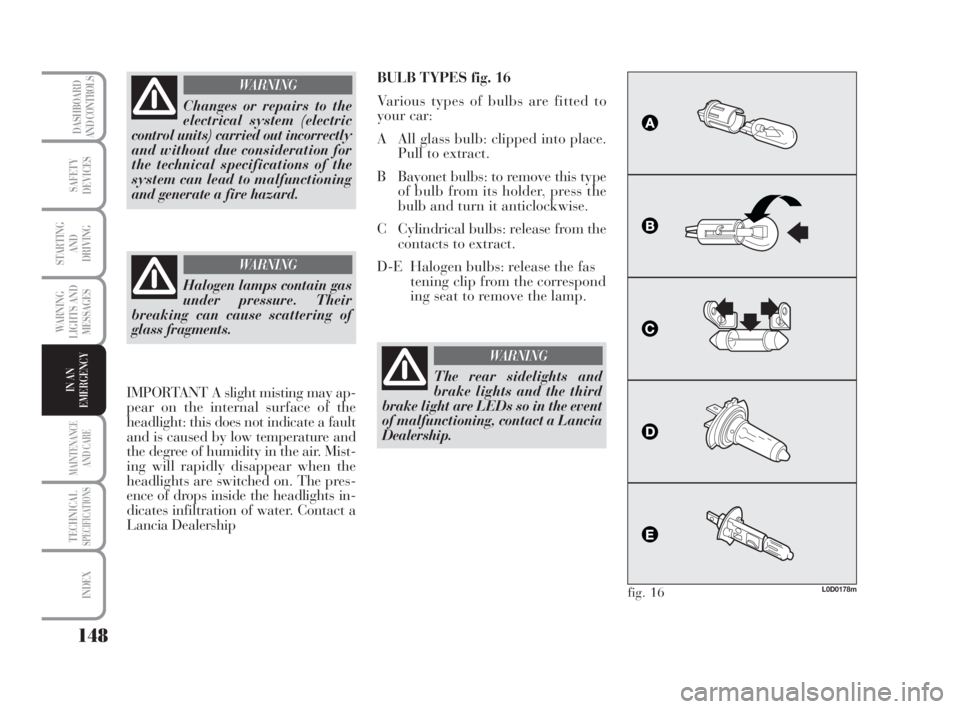
148
WARNING
LIGHTS AND
MESSAGES
MAINTENANCE
AND CARE
TECHNICALSPECIFICATIONS
INDEX
DASHBOARD
AND CONTROLS
SAFETY
DEVICES
STARTING
AND
DRIVING
IN AN
EMERGENCY
Changes or repairs to the
electrical system (electric
control units) carried out incorrectly
and without due consideration for
the technical specifications of the
system can lead to malfunctioning
and generate a fire hazard.
WARNING
Halogen lamps contain gas
under pressure. Their
breaking can cause scattering of
glass fragments.
WARNING
BULB TYPES fig. 16
Various types of bulbs are fitted to
your car:
A All glass bulb: clipped into place.
Pull to extract.
B Bayonet bulbs: to remove this type
of bulb from its holder, press the
bulb and turn it anticlockwise.
C Cylindrical bulbs: release from the
contacts to extract.
D-E Halogen bulbs: release the fas
tening clip from the correspond
ing seat to remove the lamp.
L0D0178mfig. 16
The rear sidelights and
brake lights and the third
brake light are LEDs so in the event
of malfunctioning, contact a Lancia
Dealership.
WARNING
IMPORTANT A slight misting may ap-
pear on the internal surface of the
headlight: this does not indicate a fault
and is caused by low temperature and
the degree of humidity in the air. Mist-
ing will rapidly disappear when the
headlights are switched on. The pres-
ence of drops inside the headlights in-
dicates infiltration of water. Contact a
Lancia Dealership
135-164 MUSA 1ed GB 10-07-2008 9:38 Pagina 148
Page 150 of 218
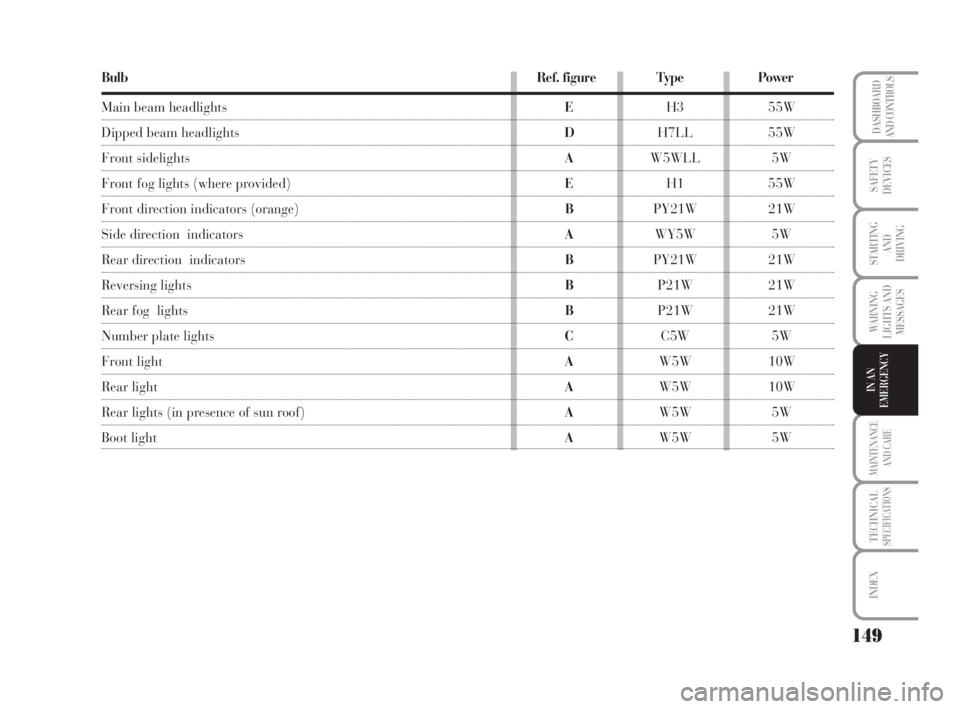
149
WARNING
LIGHTS AND
MESSAGES
MAINTENANCE
AND CARE
TECHNICALSPECIFICATIONS
INDEX
DASHBOARD
AND CONTROLS
SAFETY
DEVICES
STARTING
AND
DRIVING
IN AN
EMERGENCY
BulbRef. figure TypePower
Main beam headlightsEH3 55W
Dipped beam headlights DH7LL 55W
Front sidelights AW5WLL 5W
Front fog lights (where provided)EH1 55W
Front direction indicators (orange)BPY21W 21W
Side direction indicators AWY5W 5W
Rear direction indicatorsBPY21W 21W
Reversing lights BP21W 21W
Rear fog lights BP21W 21W
Number plate lights CC5W 5W
Front light AW5W 10W
Rear lightAW5W 10W
Rear lights (in presence of sun roof)AW5W 5W
Boot light AW5W 5W
135-164 MUSA 1ed GB 10-07-2008 9:38 Pagina 149